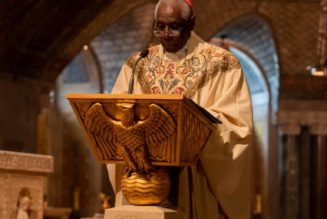An in-depth look at the history of the sacrament of penance on the big screen from the silent era to today.
Steven D. Greydanus
From the earliest days of the silent era, the Church has taken an interest in the world of cinema — and vice versa.
From the Church’s side, iconography and imagery in various forms, liturgical and otherwise, have a perennial place in Christian culture, and the power of images to educate is fundamental to the Catholic imagination.
From the perspective of filmmakers, church buildings, ecclesiastical vestments and the liturgy represented for much of Christian history the most impressive spectacle in most people’s regular experience, and this new form of spectacle took a natural interest in the photogenic trappings of the Catholic tradition.
Of the seven sacraments at the heart of the Church’s life, from the very beginning perhaps the most intriguing to filmmakers has been, ironically, the least visually impressive — a hidden rite involving only the minister and the recipient.
Perhaps the very secrecy surrounding the sacrament of confession was part of what attracted filmmakers to depict it. Anyone can witness the Eucharistic liturgy, an ordination or a wedding, and anyone can be present at the anointing of a sick person, but what transpires in confession can only be imagined — which is the cinema’s stock in trade.
Penance is also, in a sense, the most dramatic (or drama-friendly) sacrament. The personality and struggles of the penitent are exposed, potentially in a unique way, and put into some kind of perspective. The seal of the confessional, too, offers dramatic possibilities that have intrigued writers since the Middle Ages.
Often enough, confession scenes have served in movies as a pretext to allow a character to articulate their spiritual or temporal struggles, whether or not any kind of sin is involved.
Despite the number of movie scenes set in confessionals, a good confession — especially as an occasion of real moral conversion, or as a staple of religious life — is a relatively rare thing on the big screen. Screenwriters have often used confession scenes for character development, for thematic reasons, or for dramatic or comic effect, but seldom as a moral turning point.
Comic Confessions
Among the earliest silent film shorts, the confession of a pretty Spanish woman was a recurring premise in risqué comedies from the French film company Pathé. One 1897 short, A Confession in Spain*, depicted a Capuchin friar, horrified by the woman’s apparently many scandalous sins, refusing her absolution. A follow-up, the 1905 The Confession, depicts the grinning, leering friar taking a quite different attitude toward the penitent.
The comic possibilities of confession continued to appeal to filmmakers decades after the silent era. Penny Marshall’s A League of Their Own (1992) essentially rehashed the joke from the 1897 Pathé short in a confession scene with Madonna’s Mae sashaying out of a confessional leaving behind a young priest obviously flustered by her presumably steamy confession. “That’s the second time he’s dropped that Bible since she’s been in there,” Rosie O’Donnell’s Doris quips during Mae’s confession.
A few years later, Penny’s brother Garry Marshall directed a very different comic confession scene in the Julia Roberts/Richard Gere romantic comedy Runaway Bride (1999). Roberts’ Maggie, wrestling with conflicted feelings over desire for revenge, tries to go to confession to a young priest, Father Norris (Donal Logue) whom she not only once dated but left at the altar — where he stayed. Further complicating her attempted “confession,” Maggie isn’t even Catholic.
Compared to the disconcerted priest in A League of their Own, Father Norris comes off rather well. He’s fairly well-adjusted in his vocation and manages to give self-absorbed Maggie some needed pushback. Maggie’s foibles, not confession itself, are the butt of the joke.
If Maggie as a non-Catholic is a kind of impostor in the confessional, it’s more common in comic confession scenes for the impostor to be on the other side of the grille. (I’m not counting cases like the gag in the 1981 Roger Moore James Bond film For Your Eyes Only where both the penitent and the priest are impostors — in this case, Bond and Q, respectively.)
 Martin Campbell’s The Mask of Zorro (1998) offers a typical example. Antonio Banderas’ scruffy Zorro-in-training, Alejandro, fleeing from soldiers, is hidden by an enthusiastically helpful friar in a confessional, where he is promptly mistaken for the priest by Catherine Zeta-Jones’ Elena.
Martin Campbell’s The Mask of Zorro (1998) offers a typical example. Antonio Banderas’ scruffy Zorro-in-training, Alejandro, fleeing from soldiers, is hidden by an enthusiastically helpful friar in a confessional, where he is promptly mistaken for the priest by Catherine Zeta-Jones’ Elena.
The humor ranges from Alejandro’s catechetical ignorance (when Elena confesses to breaking “the fourth commandment,” he sputters, “You killed somebody?”) to Elena confessing her lustful thoughts about the handsome masked man to the man himself — though this is couched less in terms of impure thoughts than dishonoring her father with her passionate ways.
It’s a funny scene, but there’s no real sense of piety or penitence behind Elena’s confession. (A similar scene in the 1940 The Mark of Zorro has Tyrone Power’s Zorro, also fleeing from soldiers, chatting up Linda Darnell’s Lolita while disguised as a friar. Lolita has a prayer in that scene with some good old Golden Age piety, but she doesn’t attempt to confess to the “friar.”)
Comic cases of confessional mistaken identity are usually staged as accidents. My least favorite case of a comic fake confession to a non-clergyman is a sacrilegious hazing stunt in Jay Russell’s 2004 firehouse thriller Ladder 49, in which new recruits are egged into confessing to a fake priest for the amusement of eavesdropping fellow firefighters.
Confessional-Seal Thrillers
One of the first non-comic approaches to the sacrament of penance was a thriller motif most famously associated with Alfred Hitchcock’s I Confess: a drama about a priest bound by the confessional seal after hearing a murderer’s confession, only to become implicated in the murder, or to see another man implicated.
Like those early French comic shorts, The Seal of the Church* (1910), by Gaston Méliès was a short film with a Spanish milieu by a French filmmaker, yet its treatment of confession was far more reverent.
The plot involves two young matadors vying for the same woman who toys with them both, leading each to think he is the favorite. In a fit of jealous rage, one kills the other with a pruning dagger seized from a friar pruning trees on the monastery grounds. Filled with sudden remorse, the murderer begs absolution from the priest, but isn’t too contrite to refrain from crowing about his revenge to his beloved.
Since the murder weapon belonged to the priest, he is arrested, but his name is cleared by the woman who identifies the real killer. The killer is slain attempting to evade arrest, and the woman, overcome with guilt for her role in the deadly violence, confesses and accepts the priest’s advice to pursue a religious vocation in the convent. This pious denouement offers a relatively rare depiction of a good confession as an occasion of moral conversion.
[embedded content]
Over the next 10 years, confessional-seal thrillers got a major boost from the Catholic playwright and filmmaker Hal Reid. Not only did he write a 1911 play, The Confession, that was adapted as a feature-length film in 1920, he also directed and starred a 1912 short called Father Beauclaire* (1912) on the same theme.
The plot of Father Beauclaire stands out among confessional-seal thrillers for its ruthless resolve: The wrongly accused priest not only allows himself to be convicted and excommunicated, but is actually executed via guillotine rather than break the seal of the confessional.
The murderer, too, is particularly ruthless, deliberately framing the priest not only by planting the murder weapon on the priest in the confessional, but even bringing his victim’s corpse to the rectory before summoning authorities.
A year later, though, having drunk himself to the point of death, the guilt-ridden murderer reveals the truth on his deathbed in a true confession to another priest, vindicating the executed priest posthumously.
 The Confession (1920), based on Reid’s play and directed by Bertram Bracken, takes an entirely different tack. In this case suspicion for the murder falls not on the priest himself but on his brother.
The Confession (1920), based on Reid’s play and directed by Bertram Bracken, takes an entirely different tack. In this case suspicion for the murder falls not on the priest himself but on his brother.
The priest, Father Bartlett (Henry B. Walthall), knows his brother Tom (Francis McDonald) is innocent, but cannot share this knowledge even with his brother, whom he urges to surrender to authorities and trust in Providence.
Eventually the priest catches up with the murderer, who is persuaded to go back and clear Tom’s name only after being mortally injured.
At the climax, as Father Bartlett races with the dying killer to save his brother from the scaffold, Tom makes what could be his final confession to another priest. “Is that all, Tom?” the priest inquires, prompting Tom to explain that he is innocent of the murder. Presumably it’s a good confession, but the point is to emphasize the penitent’s innocence rather than his conversion.
[embedded content]
In Reid’s dramas, the killer takes responsibility for his crimes and clears the innocent man’s name only when he himself is dying. Deathbed confessions are well and good — but what if the dying killer recovers?
That’s the premise of John Farrow’s 1939 proto-noir thriller Full Confession. After the wrong man is convicted, the real killer, Pat McGinnis (Victor McLaglen), makes a deathbed confession to a priest, Father Loma (Joseph Calleia) — only to survive thanks to a blood transfusion from the priest himself.
Once his life is no longer in jeopardy, McGinnis disavows his confession to the priest as delirium. The priest, though, holds the killer’s feet to the fire, pressing him to confess to police both for his soul’s sake and for the sake of the innocent man, who faces execution.
“You will pay for your sins until the day you die,” the priest badgers him. “I can’t accuse you. But I shan’t have to. Your own conscience will be your accuser. Two dead men on your conscience, McGinnis. They’ll be at your heels as close as the shadow to the foot of the Cross.”
Under pressure from the priest’s considerable arm-twisting, McGinnis lashes out at Father Loma, seriously injuring him. In a melodramatic twist, Father Loma winds up in a hospital needing a blood transfusion of his own.
In a single act of conversion, McGinnis both saves the priest’s life by returning the blood donation and confesses to the murder, saving the innocent man’s life and his own soul. The last shot shows McGinnis, having sworn to his guilt “by all the saints,” being led in police custody past a statue of the Virgin Mary, beatific peace on his face as he goes to prison and perhaps to his execution.
[embedded content]
Though not the most interesting confessional-seal thriller, Hitchcock’s I Confess is by far the most famous — and, with the Master of Suspense’s stamp on the material, the theme has been less popular with later filmmakers.
Where Reid’s dramas and Full Confession focused to some extent on the killer’s own moral conflict and ultimate conversion, I Confess (based on a 1902 stage play by Paul Anthelme) focuses on Montgomery Clift’s Father Michael Logan as a martyr in spirit for the confessional seal.
Confession and conversion are not linked in I Confess. Although initially the murderer, Keller (O.E. Hasse), seems full of remorse both for the unplanned homicide (the outcome of a burglary gone wrong) and for the abuse of Father Logan’s kindness, his motive for confessing is only “I must tell someone.”
Before long, his concern not to be caught crowds out all other considerations, even when suspicion falls on Father Logan. Notably, Father Logan is never seen confessing himself — a dramatic possibility that could develop his character and motives, but wouldn’t serve Hitchcock’s dramatic and suspense interests.
As in The Seal of the Church, the murderer is exposed by the conscience of a woman — in this case, Keller’s wife (Dolly Haas), who can’t bear to see the consequences of her husband’s misdeeds fall on the innocent priest.
Unstable and panicking, Keller impulsively shoots his own wife and is soon afterward fatally shot by police. As he dies, Keller begs Father Logan’s forgiveness, and the priest pronounces the Latin words of absolution. Keller’s death isn’t without poignance, but his absolution in extremis falls well short of what we would hope for in a deathbed confession.
Though not a thriller, the provocative 1994 drama Priest, directed by Antonia Bird, depicts a young homosexual priest struggling with the knowledge that a young girl has revealed to him in confession that her father is sexually abusing her. Although the girl ultimately embraces and forgives the disgraced priest, who is rejected by the community after being arrested for gay sex in a car, the film’s argument seems to be for scrapping the seal of the confessional, along with clerical celibacy and the Church’s teaching on homosexuality.
Ambushing the Priest in the Confessional
The confessional seal isn’t the only way the sacrament can be misused to manipulate a priest.
The priest is in a way a prisoner of the confessional, and his duty to give a hearing to anyone who comes to him, or to hear the confession of a dying man even at great personal risk, also makes the priest vulnerable.
[embedded content]
Take John Ford’s 1947 The Fugitive, a loose adaptation of the Catholic writer Graham Greene’s novel The Power and the Glory, about a conflicted, unnamed “whisky priest” in an unnamed Latin American state during a Communist anti-religious purge.
Playing a cleaned-up version of Greene’s protagonist, Henry Fonda spends much of the film trying to escape the country while a treacherous informant (called “the mestizo” in the novel) tries to betray him to authorities for a reward.
Although the fugitive priest tries to deny his clerical status, the informant brushes this aside: “I can find out easily, can’t I? All I have to say is ‘Hear my confession, Father … Bless me, Father, for I have sinned!’ You cannot refuse a man in mortal sin, can you?”
Despite this, the priest ignores his pleas, fleeing in dismay — but in the end, having successfully escaped to another state, the priest is pursued by the informant, who spins a yarn about a dying violent criminal (identified in the film as “el gringo”) back across the border wanting to make his last confession. Suspecting a trap, the priest goes anyway, to his martyrdom.
Sometimes a hostile interlocutor invades the confessional, not to confess but to ambush the priest with his or her objections or grievances against religion, the Church, or God himself.
[embedded content]
In such cases, a lot depends on the priest one happens to get. In the 1961 French film Léon Morin, Priest, written and directed by Jean-Pierre Melville, a young widow and mother named Barny (Emmanuelle Riva) gets more than she bargained for.
A militant Communist living in the French Alps during the Italian occupation early in World War II, Barny randomly seeks out a priest to argue with, wandering into a confessional and opening with the charge “Religion is the opiate of the people!”
“Not necessarily,” the young priest replies without missing a beat. “It’s been diluted by the bourgeoisie in its own interests.” Progressive, intellectual, theologically and pastorally sophisticated, Father Léon Morin (Jean-Paul Belmondo) keeps Barny off-balance with judo-like replies redirecting the force of her attack.
He’s also a bit domineering. Before Barny leaves the confessional, Father Morin has somehow gotten her to admit at least some of her faults, to ask forgiveness despite her disbelief, and even to accept absolution and penance. Not only that, she readily agrees to let him lend her some spiritual books to read.
It’s one of the most affecting absolution scenes I’ve ever seen. Despite her adamant disbelief, Barny is unexpectedly vulnerable, moved not only by the young priest’s sincerity, but also by the reconnection with the religious tradition of her youth — by an awareness of her shortcomings and by the possibility that the God whose existence she denies may in fact forgive her. (The priest’s sex appeal may also be a factor; later comes a second, painful confession scene in which Barny, now Catholic, must confess her own failed attempt to seduce Father Morin to the priest himself.)
[embedded content]
A more haphazard confessional buttonholing takes place in Roger Michell’s 2002 morality play Changing Lanes, starring Ben Affleck and Samuel L. Jackson.
Late in the film, an exhausted Gavin Banek (Affleck) wanders into a church during a Good Friday service, attracted by the sung Veneration of the Cross, and accidentally sits down in a confessional seat.
When the priest opens the slide, Banek explains that he doesn’t want confession. Before long, though, he tells the priest, “I came here for some meaning… I want you to give the world meaning for me.”
The priest’s response — “Why does the world need meaning?” — has a bit of Father Morin’s judo in it, but perhaps the question is too open-ended.
“Why…?! Because the world’s a sewer!” Banek explodes. “Sometimes God like to put two guys in a paper bag and just let them rip!”
The scene ends with Banek’s outburst; the priest is given no opportunity to reply. The confessional is simply a forum for Banek’s grievance against God.
Literal Ambushes
Confessional ambushes can be literal — even deadly.
Such ambushes set the action in motion in a pair of what might be called black comedies, each made by one of the Irish-British McDonagh brothers, Martin and John Michael. In each film, a man targets a priest in a confessional, not for argument, but for murder.
In Martin McDonagh’s 2008 In Bruges, Colin Ferrell plays a rookie hitman named Ray who has been hired to murder a priest. Perversely, he goes to his victim for “confession,” admitting to cold-blooded murder — “for money, Father…not out of anger, not out of nothing. For money.”
Only when the priest inquires who Ray’s victim was does Ray reveal the cruel truth: “You, Father.” As in Changing Lanes, the priest isn’t allowed to reply; moments later his body is riddled with bullets — one of which goes awry and, to Ray’s horror, kills a young boy waiting to make his own confession. (The implication is that while the priest may or may not have been guilty of something, the very sins of the boy, listed on a scrap of blood-spattered paper, are innocent.)
[embedded content]
The doomed priest in John Michael McDonagh’s Calvary gets considerably more dignity, precisely because the killer’s motives are far more personal.
Father James Lavelle (Brendan Gleeson, who played Ray’s mentor in In Bruges) is targeted by a bitter man who was horrifically sexually abused as a child. In his twisted logic, the victim has decided to take his revenge on the Church, not by killing a bad priest, but precisely by killing a good one.
Like Father Morin, Father Lavelle is up to the challenge, though not overwhelmingly so. He doesn’t engage in verbal judo, but doesn’t let himself be thrown off balance either. He’s like a sumo wrestler, solid and immovable. “I’m here to listen to whatever you have to say” is his straightforward response.
After delivering the death threat — to be carried out not immediately, but a week later — the man asks whether the priest has anything to say. “Not right now, no,” Father Lavelle responds, “but I’m sure I’ll think of something by Sunday.”
This confession scene establishes Father Lavelle as a tough, realistic cleric with the emotional intelligence to intuit what people want and need and the nerve and discipline to put himself at their disposal.
Father Lavelle spends the next week — what may be, and in fact is, the last week of his life — ministering as best he can, for the most part heroically, to the generally unreceptive people of his rural village in western Ireland.
This includes an ambiguous quasi-confession scene in which a psychopathic young serial killer (Gleeson’s son Domhnall Gleeson) jokes about the girls he killed, but also earnestly expresses a wish to be forgiven and to be innocently reunited with his victims in heaven. (Whether or not Father Lavelle gives him absolution isn’t shown.)
Confession In Extremis
Although we don’t see Father Lavelle make his own confession during his last week, it would be odd for a priest to go open-eyed to his death without receiving the sacrament of penance. (We do know that Father Lavelle has made spiritual preparation for death; when the killer warns him, “Say your prayers, Father,” his last words are “I’ve already said them.”)
The confession in extremis — whether a literal deathbed or death-row confession or a confession when death is foreseen — has been featured in films from the silent era on (e.g., Father Beauclaire; Full Confession).
[embedded content]
D.W. Griffith’s celebrated silent tetraptych epic Intolerance (1916) includes a dramatic death-row sequence called “The last Sacrament” at the climax of the “Modern Story,” with “The Boy” wrongly sentenced to death. A priest comes to The Boy’s cell, hears his last confession, administers Holy Communion, and accompanies him on the journey to the scaffold. (The Boy is ultimately saved at the last minute by a gubernatorial pardon.)
Perhaps the most painful note in The Fugitive comes at the very end as Fonda’s priest, near his execution, is confronted by the informant, yet again begging absolution from the doomed priest he has betrayed.
In Greene’s original novel, there is a further twist of the knife: Shortly before his death, the whisky priest encounters a lapsed priest collaborating with government authorities — a man with the power to grant him absolution before dying. Yet he fears to do so, and the protagonist, going to his death because he would not risk leaving a man to die unshriven, dies unshriven himself.
This grace is not denied the anonymous protagonist (Claude Laydu) of Robert Bresson’s Diary of a Country Priest, who, like Greene’s whisky priest, encounters a lapsed priest toward the end of his life: a former fellow seminarian who has broken his ordination vows for what he calls an “intellectual life.” As Bresson’s protagonist dies, he asks for absolution, which the other reluctantly grants; the lapsed priest even agrees to meet with the dying priest’s old mentor.
 There’s more than one confession scene in the fact-based 1983 World War II thriller The Scarlet and the Black, starring Gregory Peck as Monsignor Hugh O’Flaherty, the “Scarlet Pimpernel of the Vatican,” and Christopher Plummer as the SS officer Lieut. Col. Herbert Kappler. One involves some pretty standard soul-searching with Monsignor O’Flaherty confessing to his ally Father Vittorio (Raf Vallone) as a pretext for agonizing about the danger and urgency of his work hiding escaped Allied prisoners of war from the occupying Nazi authorities.
There’s more than one confession scene in the fact-based 1983 World War II thriller The Scarlet and the Black, starring Gregory Peck as Monsignor Hugh O’Flaherty, the “Scarlet Pimpernel of the Vatican,” and Christopher Plummer as the SS officer Lieut. Col. Herbert Kappler. One involves some pretty standard soul-searching with Monsignor O’Flaherty confessing to his ally Father Vittorio (Raf Vallone) as a pretext for agonizing about the danger and urgency of his work hiding escaped Allied prisoners of war from the occupying Nazi authorities.
But there’s also a subplot involving the importance of confession in extremis. After Father Vittorio is captured by the Nazis and sentenced to execution, Monsignor O’Flaherty, determined to give his friend absolution before he dies, walks boldly into Regina Caeli prison disguised as an SS officer.
The depiction of the sacrament isn’t exactly by the book. Father Vittorio confesses no sins, explaining with a gesture to a cross scratched on the cell wall that “I have already made my confession to God.” Nor do we see the moment of absolution, which presumably happens offscreen; instead, they pray the Hail Mary together and Monsignor O’Flaherty gives Father Vittorio a drink of holy water (“It’s all the better for that”).
[embedded content]
A running theme in Gran Torino (2008), directed by and starring Clint Eastwood, is whether crotchety old Walt Kowalski (Eastwood) will or won’t return to confession before he dies. A young priest, Father Janovich (Christopher Carley), who was close to Walt’s late wife, periodically harasses him about this in keeping with her wishes. Walt, though, cynically dismisses Fr. Janovich as “an overeducated 27-year-old virgin who holds the hands of superstitious old women and promises them eternity.”
Nevertheless, before his ambiguously sacrificial death, Walt makes his final confession. After decades away from the sacrament, he confesses just three sins, two very specific (an adulterous kiss and an income-tax omission) and one very general (his paternal distance from his sons).
Though underwhelmed by this anticlimactic, pedestrian confession, Father Janovich pronounces absolution with a stereotyped penance of Hail Marys and Our Fathers, and Walt declares himself at peace. Later, at Walt’s funeral, Father Janovich’s homily pays homage to just how much Walt taught the naive priest about life.
Gran Torino doesn’t squint hard at Walt’s faults, either during his confession or otherwise, but his confession is fine as far as it goes.
Confession as Conversion or Spiritual Seeking
When it isn’t used for comic effect, to prepare for death, or to constrain the priest either through the seal or through his duty to hear confessions, confession can be an occasion of dramatic conversion, or at least an opportunity to contemplate or open oneself to the possibility of conversion.
Even when some essential element might be lacking, and the sacrament’s validity is doubtful at best, divine grace, and the mysterious workings of the heart, may be in play. (Even the comic confession in Runaway Bride is an example.)
One of the most powerful conversion scenes in all of cinema is the central dialogue in Diary of a Country Priest, in which the frail young priest confronts the bitter countess (Marie-Monique Arkell) who blames God for the death of her son and affects indifference regarding her husband’s infidelities while taking out her anger on their daughter.
Although everywhere else the priest meets with failure and rejection, here he somehow finds the words, or is given them, to reconcile the countess to God. This is the priest’s one real pastoral success, though when the countess dies that night he is held responsible for her death. It barely counts as a confession scene, though, since if the priest gives her absolution, it’s offscreen.
[embedded content]
Roland Joffé’s The Mission offers one of the most stunning depictions in cinematic history of actual penance — the works of satisfaction prescribed by the priest to help uproot sinful tendencies (concupiscence) from the heart and re-orient one toward God.
Robert DeNiro plays the 18th-century Spanish slave trader Rodrigo Mendoza, who falls into inconsolable despair after killing his brother for sleeping with his fiancée. When Jeremy Irons’ Jesuit priest Father Gabriel challenges Mendoza to seek redemption, Mendoza answers that “there is no penance hard enough for me.”
“But do you dare to try it?” Father Gabriel presses.
“Do I dare?” Mendoza retorts. “Do you dare to see it fail?”
This exchange effectively sets up a contest between Catholic praxis and Mendoza’s despair. The former slaver’s self-chosen penance is unsupportably harsh: Accompanying the Jesuits on their return to the South American mission territory of the Guaraní Indians, where he once hunted for slaves, Mendoza doggedly drags a heavy net containing armor and effects from his military days.
Long after the other brothers believe sufficient penance has been done, Father Gabriel sanctions Mendoza ongoing labors, because until Mendoza is satisfied with his penance, it isn’t enough.
Release comes unexpectedly when the party finally arrive at Guaraní territory and an indigenous man approaches the exhausted Mendoza with a knife. The ex-slaver expects to die, but the Guaraní — a Christian convert of Father Gabriel and his brothers — cuts the burden from Mendoza and sends it tumbling down the mountain.
Overwhelmed by this astonishing gesture of forgiveness from one who should be an implacable enemy, a weeping Mendoza finds that if the Guaraní can forgive him, then it is not unthinkable that he can forgive himself and even accept God’s forgiveness.
[embedded content]
Francis Ford Coppola’s widely disparaged The Godfather Part III (1990), for all its faults, has an interesting scene set in Rome in 1978 with Al Pacino’s Michael Corleone confessing to the future Pope John Paul I — not the real-life Cardinal Albino Luciani, but the fictional Cardinal Lamberto (Raf Vallone, The Scarlet and the Black’s Father Vittorio).
Though tormented with guilt over his brother Fredo’s murder in The Godfather Part II, Michael reasonably demurs when the cardinal invites him to confess: “What’s the point of confessing if I don’t repent?” The future pope, though, brushes this aside, challenging Michael that he has nothing to lose.
Haltingly, Michael gestures at the worst of his sins, breaking down over Fredo’s murder. Cardinal Lamberto’s reply is crucial to the scene: “Your sins are terrible, and it is just that you suffer. Your life could be redeemed, but I know that you don’t believe that. You will not change.” Despite this, the cardinal pronounces the words of absolution.
Shaken, Michael later tells his sister Connie that confessing to Cardinal Lamberto — “a good man, a true priest” — has “changed things” for him.
This is a pretty good depiction of confession as an occasion of at least the possibility of moral change, with one crucial caveat: Cardinal Lamberto is too certain of Michael’s unwillingness to change to permit absolution to be granted. Had the cardinal said something like “I doubt you will change,” the effect would be quite different.
 In 2013 there were a pair of movies, Stephen Frears’ Philomena and James Gray’s The Immigrant, in which vulnerable women attempt confessions that end unsatisfactorily.
In 2013 there were a pair of movies, Stephen Frears’ Philomena and James Gray’s The Immigrant, in which vulnerable women attempt confessions that end unsatisfactorily.
In both cases the women needed something more from the Church than absolution. Judy Dench’s Philomena Lee needed support and justice regarding the child forcibly taken from her as a teenager in a Magdalene laundry. Ewa (Marion Cotillard), a Polish immigrant living in 1920s New York under the sway of a manipulative man named Bruno (Joaquin Phoenix) who forces her into prostitution, needs support breaking away from Bruno and being reunited with her sister.
Philomena, which has a somewhat jaundiced view of the Church, depicts its protagonist as a bit of a simpleton, which perhaps helps to rationalize her loyalty to the Church in spite of how she was wronged. At one point she tries to go to confession, but with the anti-Catholic jeers of Steve Coogan’s skeptical journalist Martin Sixsmith ringing in her ears — “It’s the Catholic Church that should go to confession, not you” — she can’t bring herself to say anything at all.
“Have faith,” the priest says as she silently weeps. “God will forgive you.” Perhaps he should instead have asked what was troubling her. In any case, Philomena leaves the confessional without a word and exits the church without touching the holy water — an expression, perhaps, of the anger at the Church that she can’t allow herself to acknowledge.
Ewa, on the other hand, confesses that she has stolen food and money and works as a prostitute. The priest strikes both cautionary and comforting notes, warning her that God punishes sin but rejoices when the “lost lamb” is found. “You must continue to have faith in your own salvation,” he says, “but you must find a way to leave that man.”
But Ewa, who needs Bruno’s help to reconnect with her sister, sees no alternative. “So maybe I go to hell,” she concludes bleakly. The priest seems decent enough, but Ewa’s plight called for a heroic response.
Routine Confession
Perhaps the most elusive form of confession in cinema, ironically, is the most common form in ordinary life: confession as a routine part of moral and religious life for Catholics.
Routine confessions are not always “good” confessions. Compare two routine confessions in two very different movies: Francis Ford Coppola’s 1974 paranoia thriller The Conversation, starring Gene Hackman, and Norman Jewison’s 1987 romantic comedy Moonstruck, starring Cher (written by Doubt’s John Patrick Shanley).
It’s been three months since Hackman’s Harry last confessed; two months for Cher’s Loretta. Both confess having taken the Lord’s name in vain. There are also small offenses relating to the seventh commandment (though Loretta says it was an accident, and the priest assures her that it was no sin). In addition, Harry has worries about his work as a surveillance expert and whether it may lead to people being hurt.
The big difference between the two confessions is how they treat their offenses against the sixth commandment. Loretta is frank, if understated, about her offense, which she self-consciously slips in between lesser infractions: “Once I slept with the brother of my fiancé” (i.e., Nicolas Cage’s Ronnie).
Harry, on the other hand, conceals the fact that he has a mistress, instead confessing only to “deliberately taking pleasure in impure thoughts.” Perhaps he is overcome by humiliation, or perhaps he resists the implication of “sinning no more.” In any case, Loretta goes home forgiven, while Harry, though on some level he genuinely wants redemption, presumably does not.
[embedded content]
Later in Moonstruck comes a second scene in which Loretta’s mother Rose (Olympia Dukakis) confronts her philandering husband Cosmo (Vincent Gardenia). “Have I been a good wife?” she asks. When he answers affirmatively, she says directly, “I want you to stop seeing her.” After a brief flash of anger, Cosmo meekly agrees. “And go to confession,” Rose admonishes, her moral triumph complete.
While I’ve generally avoided saint biopics and the like in this discussion, one is worth consideration for its remarkable depiction of the difficulties of what should be routine confession.
[embedded content]
Paul Cox’s 1999 Molokai stars David Wenham (Faramir in The Lord of the Rings) as St. Damien de Veuster, the 19th-century “Apostle to the Lepers” on the Hawaiian leper colony of Molokai.
Damien, a devout Belgian priest of the Congregation of the Sacred Hearts of Jesus and Mary, would certainly be a regular penitent, if his perpetual exile on Molokai ministering to lepers didn’t make each confession in his life an exceptional occasion.
It’s one of a number of longstanding grievances that Damien holds against the authorities in Honolulu, both ecclesiastical and civil, that he is almost never able to make confession.
Eventually Bishop Maigret of Honolulu (Leo McKern), convicted in conscience that Damien’s canonical rights are being neglected, sails to Molokai to hear his confession — but the ship’s captain won’t land on the island, and, when Damien sails out in a dinghy to meet the ship, the captain won’t permit him on board.
The solution they hit on is for Damien (who is Belgian) to shout his confession to Bishop Maigret (who is French) in their native French, a language understood by no one else on either vessel. It’s a startling, subversive dramatization of the essential privacy of the sacrament, celebrated openly, in front of many other people, in a highly unusual setting, in a way that is still completely private.
[embedded content]
Perhaps the most winsome cinematic depiction of routine confession is in the Coen brothers’ 2016 Hollywood period comedy Hail, Caesar!, starring Josh Brolin as a fictional version of Eddie Mannix, a real-life Hollywood “fixer” whose work involved protecting the public images of Hollywood stars from their own bad behavior.
A devout Catholic burdened by scrupulosity, Mannix confesses several times a week. “It’s too often, my son,” a weary priest protests, “you’re really not that bad.”
Far from being a ridiculous figure, though, Mannix humanizes the sacrament, because he embodies the essential virtue of the Coens’ moral universe, decency. At the same time, he’s reasonably troubled by his failings, which include smoking cigarettes behind his wife’s back (and thus lying, in effect or in fact, to his wife).
“It’s hard,” Mannix says. “But I’m trying.”
In those five words is a simple but striking insight — vanishingly rare in the whole history of cinema — into what confession is and ought to be for faithful Catholics.
For Mannix, confession is an essential but routine part of the ongoing struggle of the moral life, a struggle that tends to be either three steps forward and two steps back or else the reverse. Leave it to Hollywood’s Jewish existentialist provocateurs, the Coens, to “get” confession to such an unusual degree.
It’s hard. But I’m trying. Of all the dramatic possibilities suggested by the sacrament of confession, this is the one that seems least likely to occur to filmmakers.
*Note: A few early silent titles are marked with an asterisk, indicating films I have not seen and which may be lost; for the plot descriptions I have relied upon contemporary plot synopses and reviews. — SDG
Deacon Steven D. Greydanus is the Register’s film critic and creator of Decent Films.
He is a permanent deacon in the Archdiocese of Newark, New Jersey.







